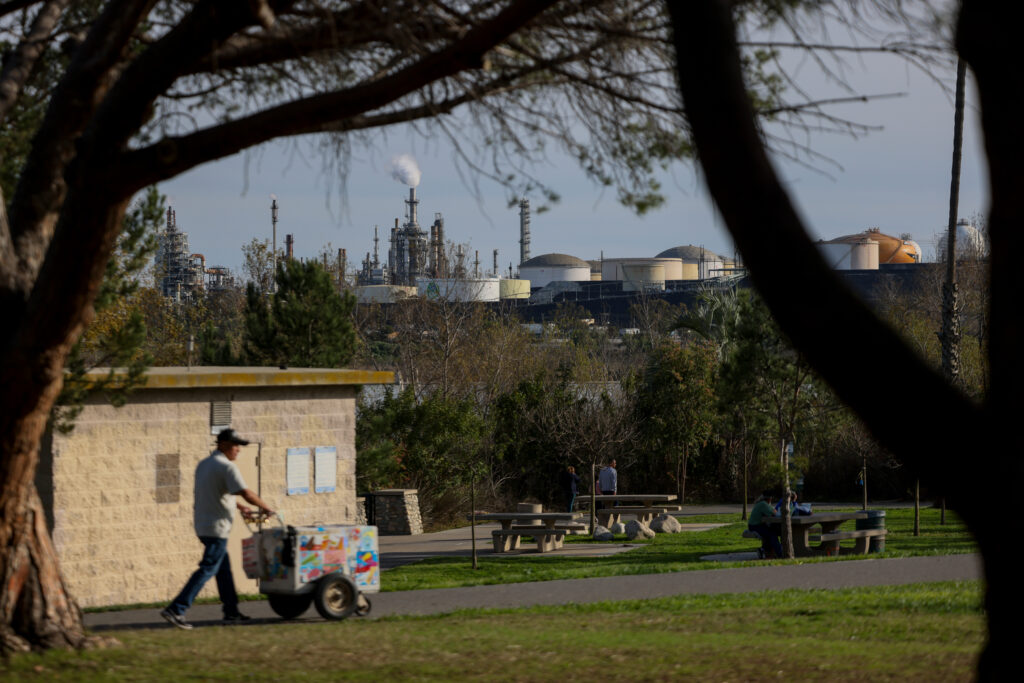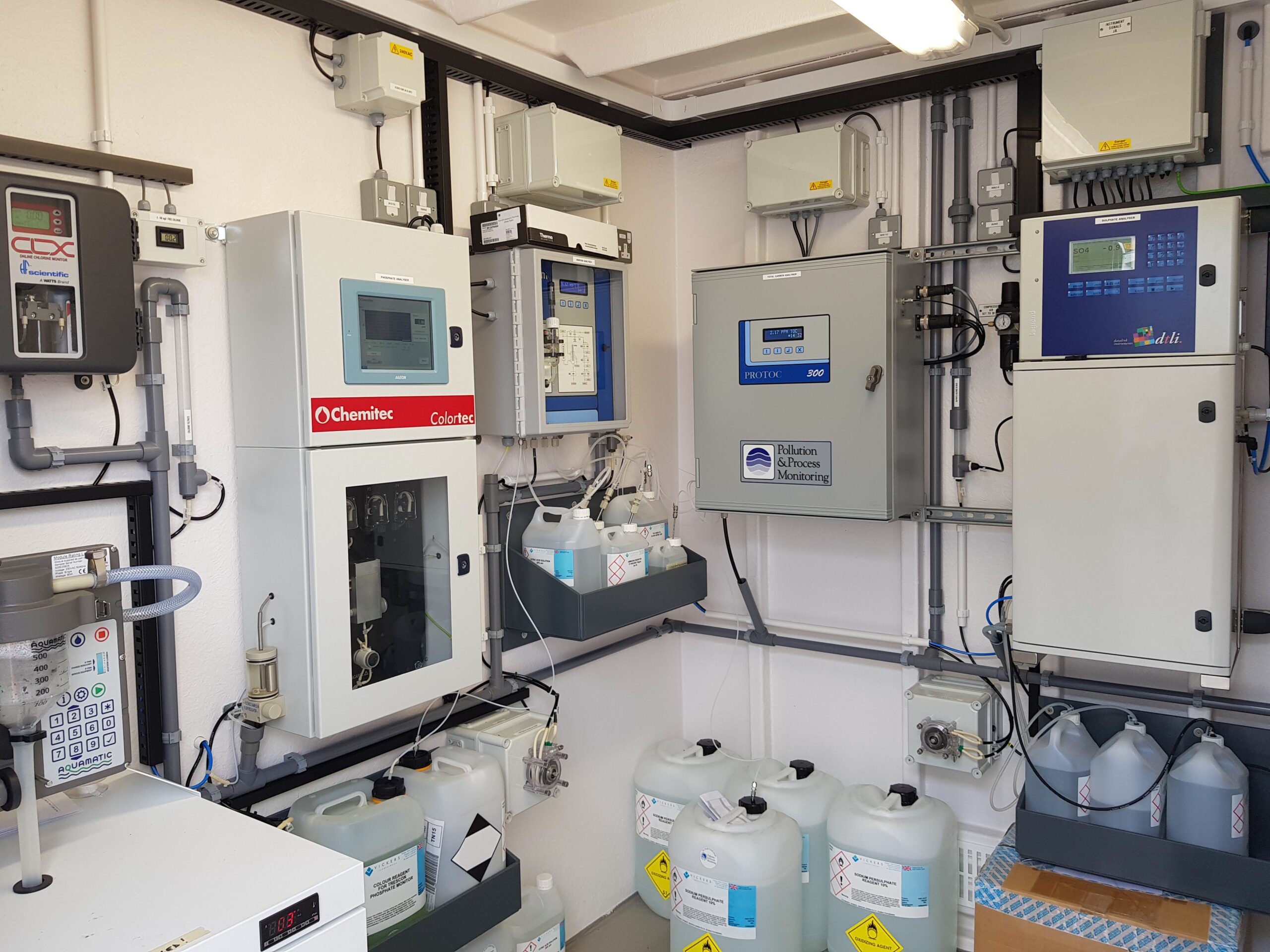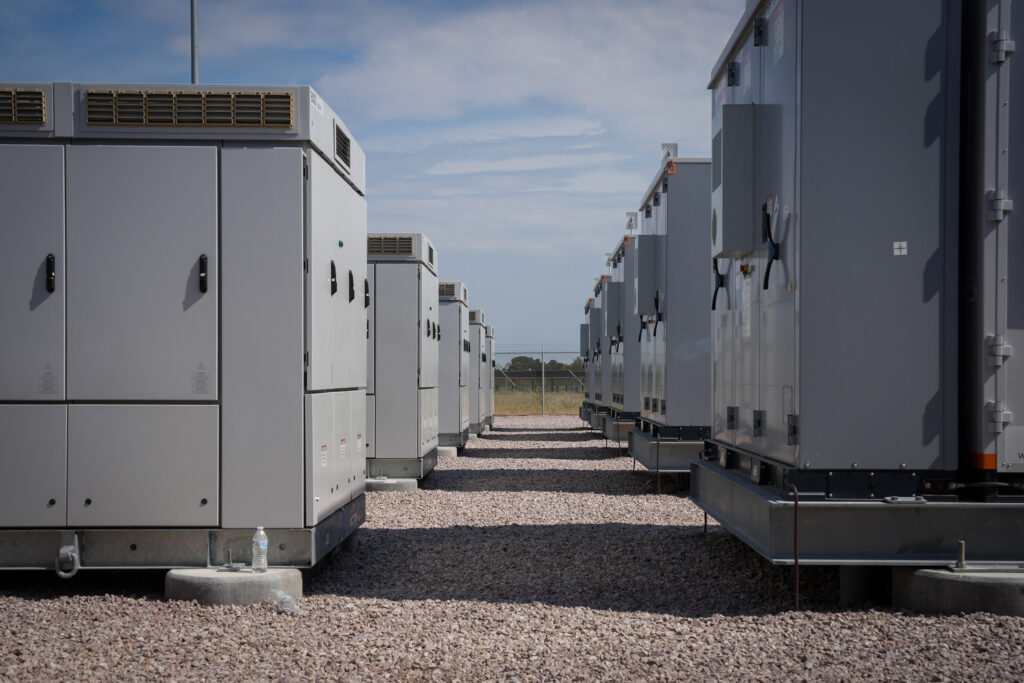CHAPEL HILL, N.C.—On a Friday afternoon in mid-January, college students hugged themselves as they lumbered through the University of North Carolina campus. Temperatures teetered just above freezing. Snow would soon skitter in from the west.
A half-mile from campus on West Cameron Avenue and overlooking two historically black neighborhoods, several drab apartment complexes and quaint 1920s homes converted to rentals, the UNC power plant labored to keep the campus buildings and dorms warm.
Since 1992, the plant has operated as a cogeneration facility, burning coal and natural gas to create electricity. Cogeneration also captures the resulting heat, which can be used for energy, improving the plant’s efficiency and decreasing the amount of fuel it burns.
But now, five years past its self-imposed deadline to phase out coal, UNC is trying to wean itself from one of the main drivers of climate change. Instead, the university is asking state environmental regulators for permission to burn up to 22,000 tons of pellets composed of paper and plastic over the next year—and possibly beyond.
We’re hiring!
Please take a look at the new openings in our newsroom.
See jobs
The pellets would be shipped from a Wisconsin factory, according to the draft air permit, to replace only a small portion of the coal. UNC has not disclosed the prices of the pellets, but court documents unrelated to this project show that in 2020, the cost to a Michigan power plant ranged from $50 to $65 per ton.
Convergen Energy, based in Green Bay, makes the pellets from hard-to-recycle materials discarded by area factories: laminated paper, adhesive labels, paper mill sludge, PET and HDPE plastics; and nonwoven fabrics, such as those used in surgical gowns, diapers and floor dusting cloths. The company says burning the pellets emits fewer emissions than coal and uses materials that would otherwise be landfilled.
UNC did not make a representative from the Energy Services Department available for an interview. Nor did the university answer written questions from Inside Climate News about the proposed air permit, the cost of the pellets and other contractual terms, and whether other alternatives had been considered.
Instead the university Office of Communications issued a statement: “We continue to explore and test new technologies and fuel options as they come to market. This latest permit modification request to test engineered fuel pellets from Convergen Energy is one step in this process.”
A Solution for Plastic Waste?
Plastic is a global problem with few easy solutions. Worldwide, more than 400 million tons are manufactured each year, and only 9 percent is recycled. Much of the rest is tossed in the trash, on roadsides and into waterways. Nineteen percent of it is burned.
The Environmental Protection Agency has permitted the burning of plastic and paper as “non-hazardous secondary waste” in power plants since 2011, when it implemented a controversial rule designating the materials as alternative fuels. This distinction allows power plants that burn these materials, like UNC’s, to avoid being regulated as incinerators.
Even though plastics are made from fossil fuels, there is a push by the chemical and waste disposal industries to burn them in lieu of coal. Just last year the Biden Administration committed $186 million in federal loan guarantees to a recycling company that converts plastic waste into fuel. It would replace coal as the fuel source at a U.S. Steel plant in Indiana.
However, there are unknowns about the technology in general and its full environmental impact. While the pellets divert some waste from landfills, the fuel type perpetuates the production and use of plastic, which harms the environment and human health.
At UNC, if the pellets fully replaced coal, levels of some pollutants, such as sulfuric acid and fine particulate matter, would decrease according to the university’s draft air permit reviewed by the N.C. Division of Air Quality. Greenhouse gases would also fall by 12 percent.
Under this scenario, the UNC plant would still burn natural gas.
Yet swapping pellets for coal would increase levels of several harmful pollutants, such as nitrogen oxides, which can produce ground-level ozone; lead, carbon monoxide and volatile organic compounds, the latter by 300 percent.

VOCs, as they’re known, are a class of chemicals, exposure to which can irritate the eyes, nose, and throat; cause headaches and nausea; and damage to the liver, kidneys or central nervous system. Some VOCs, like benzene, are known to cause cancer, according to the U.S. Environmental Protection Agency.
Steven J. Brooks, Convergen’s chief financial officer, disagreed with the state’s projections and said smokestack testing at the University of Missouri, which uses a different boiler system than UNC, showed no VOCs.
Plants that burn the pellets can emit varying levels of pollutants, based on equipment, fuel mix and pollution controls.
UNC is also estimating that if it burns pellets instead of coal, the plant will emit more than 11 tons of the pollutant acrolein, classified as a hazardous air pollutant under the Clean Air Act.
That emissions rate would rank UNC as the sixth-largest emitter of acrolein in North Carolina, according to the EPA’s 2020 National Emissions Inventory. (The inventory lists actual emissions; UNC lists its potential emissions.)
The university’s permit application allows UNC to test the pellets for 12 months from the first time it burns them. If UNC decides to continue to use the pellets, it must disclose this in the air permit and provide an emissions analysis. Alternately, if UNC decides not to use the pellets, it can remove them from the permit.
In an email, Brooks wrote that since 2009 the company’s pelletized fuel has been permitted in dozens of facilities across multiple states, but he did not list those locations.
Public documents show that the University of Missouri at Columbia, a power plant in the Upper Peninsula of Michigan and Manitowoc Public Utilities in Wisconsin are among them.
Some plastics, including a type that Convergen uses in its pellets, HDPE, are known to contain toxic PFAS, or can become contaminated during manufacturing, according to the EPA. The factory also accepts paper mill sludge, according to the company website, another potential source of the compounds, according to several scientific studies.
Brooks said the company does not accept plastics containing PFAS. “Our materials go through an extensive testing and screening process prior to being incorporated into our fuel,” he said.
But in a single study conducted in 2019, Wisconsin regulators tested Convergen pellets for 26 types of PFAS. State records show the pellets contained four types at a total level of 8.2 parts per trillion. Brooks attributed the amount “to the greater environment.”
The EPA has not set air emissions standards for PFAS; in drinking water, the maximum contaminant level ranges from 4 to 10 parts per trillion for five types of the compounds, a fraction of the estimated 15,000 in use.
Traditional treatment methods can’t remove PFAS in water or air. Brooks said “combustion has been shown to destroy PFAS,” but North Carolina regulators disagree. “It is unlikely that the control devices would reduce any PFAS emissions,” the UNC draft air permit reads.
Based on the Wisconsin data, the N.C. Division of Air Quality calculated that the UNC plant would emit just over a pound of PFAS per year. UNC would be required to test its emissions for PFAS annually.
That’s too infrequent, Patrick Anderson, staff attorney with the Southern Environmental Law Center, said. Emissions levels for PFAS and other pollutants can vary based on the composition of the pellets.
“What we’re seeing is the composition of these pellets can change a lot over time,” ranging from 15 percent to 50 percent plastic, Anderson said. “I don’t think DAQ or UNC have a good understanding of what’s going to happen with a lot of these emissions.”
Brooks said the composition of the pellets is “highly consistent” —at least 60 percent paper or cellulose and no more than 40 percent plastic. No trees are harvested for use in Convergen’s fuel, Brooks said. The company can custom-formulate fuels using traditional wood biomass, according to its website, as well as oat hulls and miscanthus, a type of ornamental grass.
UNC’s emissions account for only one part of the overall pollutant load from the pellet manufacturing. It does not include the emissions from the paper mills and plastics factories, nor Convergen’s plant itself.
“I don’t think DAQ or UNC have a good understanding of what’s going to happen with a lot of these emissions.”
— Patrick Anderson, Southern Environmental Law Center
Convergen’s annual filings with the Wisconsin Department of Natural Resources show that in 2023 the plant emitted more than 12 tons of particulate matter and 135 tons of greenhouse gases, as well as much smaller amounts of 12 other pollutants.
Brooks said all of the Convergen manufacturing processes are electric; the plant’s direct emissions are from natural gas heaters in the buildings.
In 2022, a data scientist and two engineers studied the emissions life cycle of Convergen’s pellets: the transport of the raw materials from plastics and paper factories to the plant, the pellet production itself, the transport of the pellets to the power plants and emissions from burning the fuel.
The authors used widely accepted international standards to compare the pellets’ life cycle emissions to those of natural gas and coal.
The study, published in 2023 in the International Journal of Life Cycle Assessment, showed mixed results. When accounting for the original production of the plastic and paper, the pellets emitted more greenhouse gases than coal or natural gas.
However, when the authors removed the original production emissions from the equation—because the pellets diverted those materials from the landfill—the fossil fuels produced more greenhouse gases.
Not counting the production emissions, the Life Cycle Assessment found that electricity generated from Convergen pellets had the lowest global warming potential impact when compared with all other forms of fossil-fuel powered sources of baseload energy, Brooks said.
The authors also ran scenarios applying renewable energy credits, which they found reduced the overall emissions burden. However, that would not reduce the pollution on hundreds of neighbors of the UNC power plant.


The study found further emissions differences, based on the composition of the pellets. The greater the percentage of paper or fiber in a pellet, the higher the greenhouse gas emissions.
There are some limitations in comparing the results to projections for UNC.
The pellets were burned in facilities within 30 miles of the plant. Convergen, though, is nearly 1,000 miles from Chapel Hill, meaning substantial energy is required in transporting the pellets to North Carolina.
Inside Convergen, Financial Turmoil
Convergen makes its pellets at a plant in an industrial area of Green Bay, best known for its football team. The company doesn’t name its suppliers, but roughly a dozen plastics facilities are scattered throughout the city. Several paper mills—Georgia-Pacific, Proctor & Gamble and Green Bay Packaging—are encamped near Convergen and along the Fox River, which bisects the city.
Since incorporating under its original name, Greenwood Fuels, in 2008, Convergen has been privately held. Its financial status is not publicly available. The company has ambitions to expand its manufacturing to other states, public records show, including Iowa. In 2022, that state’s Economic Development Authority Board awarded Convergen more than $587,000 in tax credits for the construction of a new $22.5 million facility in Fairfax, according to Kanan Kappelman, a Development Authority spokesperson.
Convergen and the state signed a contract last November. The funds are contingent on creating 11 jobs by Nov. 30, 2025. However, it’s unlikely the company will make the deadline.
“Based on conversations with the company regarding initial project delays, we are expecting a request to amend this timeline,” which will require board approval, Kappelman said.
Because of delays, Kappalman said, the company has not received any incentives.
A federal court case reveals there has been financial turmoil inside the company. Convergen has been embroiled in a five-year legal dispute with its former owner, multinational conglomerate Libra Group, with millions of dollars at stake.
“This is a case about corporate betrayal at the highest level; a saboteur who stole millions of dollars from his employer with the help of fellow deceitful insiders and corrupt outside investors,” attorneys for the Libra Group wrote in its legal complaint, filed in the Southern District of New York.
This story is funded by readers like you.
Our nonprofit newsroom provides award-winning climate coverage free of charge and advertising. We rely on donations from readers like you to keep going. Please donate now to support our work.
Donate Now
The saboteur, Libra Group alleges, is Steven Brooks, the current Convergen CFO.
Since the litigation is ongoing, Brooks declined to comment on the case.
As Convergen’s senior vice president of investments under Libra, Brooks allegedly committed fraud in 2019 by arranging a $5.8 million sale of Convergen to a separate company, NianticVista. But Brooks was also a co-owner of NianticVista, according to court documents, meaning he allegedly sold the company in part, to himself.
In the complaint, Libra officials say they confronted Brooks “with his self-dealing scheme in a face-to-face recorded meeting in Manhattan. Brooks, after repeated denials, confessed to his fraudulent conduct, saying ‘I am very much responsible’ and acknowledged the knowing participation of the other defendants.”
Brooks allegedly failed to procure other competing bids, the complaint reads, “going so far as to rebuff interest from other potential buyers.” The purchase price was “at least $10 million less than the fair market value of the pellet plant.”
The litigation is now in arbitration. A letter to the court dated Dec. 4, 2024, said the arbitration panel could decide the case by later this month or in early February.
The University of Missouri’s Experience
Convergen says its pellets “provide universities with a solution that is both renewable and more sustainable for steam generation than utilizing fossil fuels, such as coal or natural gas. Multiple universities have successfully used Convergen fuel to improve sustainability and reduce CO2 emissions.”
The University of Missouri at Columbia operates a cogeneration plant that burns 60 percent natural gas and a little more than a third wood waste biomass, with coal and the Convergen pellets making up the remaining 5 percent, said Travis Zimpfer, the university’s deputy spokesperson. In addition to some on-site solar, the university also purchases wind energy from a power purchase agreement.
The university began testing Convergen pellets in 2018, after power plant staff attended a conference and met company representatives, Zimpfer said. In 2021, the university received a state air permit to permanently burn Convergen pellets in four of the five boilers at its cogeneration plant, state records show.
The plant uses about 1,000 to 2,000 tons of the pellets each year, Zimpfer said.
“Convergen has been willing to work with us and meet our needs,” Zimpfer said.
Zimpfer said emissions data show that the pellets significantly reduce sulfur, mercury and hydrogen chloride emissions compared with coal. “The pellets are about half paper, which makes them considered a renewable source,” Zimpfer said. “Obviously the plastics aren’t renewable, but the Convergen pellets don’t contain mercury, chlorine or sulfur, and the plastic isn’t going into the landfill. So there are some benefits.”
UNC sees Convergen’s pellets as a way to solve a problem identified 16 years ago, when the university issued its inaugural Climate Action Plan. At the time, the university set a goal of carbon neutrality by 2050.
Then in 2010, Holden Thorp, the university’s chancellor and a chemist by training, announced UNC would be free of coal within a decade.
That didn’t happen.
Only in 2021 did UNC update its Climate Action Plan, which calls for the elimination of coal “as quickly as is technically and financially feasible,” to help the campus achieve net-zero carbon emissions sooner—by 2040.
The university had planned to replace 20 percent of its coal with wood pellets, which it tested in 2010 and 2011. UNC jettisoned that strategy after “certain assumptions about … wood pellet technologies that failed to materialize.”
Nonetheless, the university has reduced its coal use by two-thirds, but as a result, has increased its consumption of natural gas. That fuel source emits methane, a climate super pollutant 80 times more potent at warming the atmosphere than carbon dioxide.
UNC has cut its greenhouse gas emissions by 37 percent since 2007, according to university data, which includes those from air travel and commuting, as well as the power plant.
The university has installed 73.5 kilowatts of rooftop solar panels, which is equivalent to powering seven to 14 homes, and is pursuing energy efficiency in campus buildings, according to the Climate Action Plan.
“Because of the urgent and immediate need for climate action, Carolina has set new, more ambitious greenhouse gas goals,” the plan reads. “Carolina is still researching better long-term solutions.”
Anderson disagrees that pellets are among the solutions. “Rather than wasting time and resources on polluting stop-gap measures,” he said, “UNC should focus on a plan to permanently transition away from fossil fuels altogether.”
About This Story
Perhaps you noticed: This story, like all the news we publish, is free to read. That’s because Inside Climate News is a 501c3 nonprofit organization. We do not charge a subscription fee, lock our news behind a paywall, or clutter our website with ads. We make our news on climate and the environment freely available to you and anyone who wants it.
That’s not all. We also share our news for free with scores of other media organizations around the country. Many of them can’t afford to do environmental journalism of their own. We’ve built bureaus from coast to coast to report local stories, collaborate with local newsrooms and co-publish articles so that this vital work is shared as widely as possible.
Two of us launched ICN in 2007. Six years later we earned a Pulitzer Prize for National Reporting, and now we run the oldest and largest dedicated climate newsroom in the nation. We tell the story in all its complexity. We hold polluters accountable. We expose environmental injustice. We debunk misinformation. We scrutinize solutions and inspire action.
Donations from readers like you fund every aspect of what we do. If you don’t already, will you support our ongoing work, our reporting on the biggest crisis facing our planet, and help us reach even more readers in more places?
Please take a moment to make a tax-deductible donation. Every one of them makes a difference.
Thank you,

















